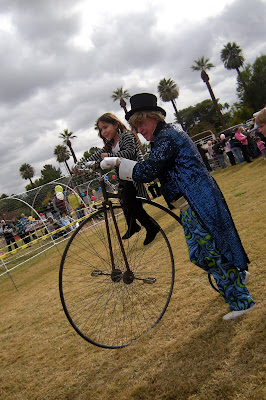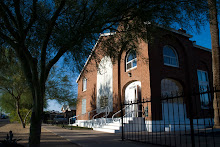Each year, a large church in the Valley puts on a Christmas show that is quite a production. There are numerous performances of the show, and some of the "standards" each year are the flying angels (trapeze artists), live animals (including camels), and snow falling on the stage -- plus much, much more that causes children's eyes to widen!
We are still able to purchase low-cost snacks through St. Mary's Food Bank, so the children enjoyed some treats while they waited.

On Friday evening, teens gathered for the final Teen Night of December, with some encouraging words from Caleb about not letting distractions get in the way of focusing on Christ.



There were a few contests in which teens could compete to earn prizes. Ever try to drink orange soda from a baby bottle?




On Sunday evening, Aim Right staff, volunteers, and some guests gathered for the annual Aim Right Christmas dinner/party.

Lots of wonderful food!


The evening had a Christmas carol theme. Caleb came dressed as the Santa of
I Saw Mommy Kissing Santa Claus.


A.J. & Jewel came dressed as
O Christmas Tree, and Jewel won the prize for being the most creative!
 Ding Dong Merrily on High, O Christmas Tree
Ding Dong Merrily on High, O Christmas Tree, the mommy of
I Saw Mommy Kissing Santa Claus, and
The Little Drummer Boy.

A creative bunch wrote a revision of
The Twelve Days of Christmas to reflect "what Aim Right gave to me," and had a jolly good time presenting their humorous rendition. Some of the funnier lines were "two messed-up cars"and "five bags of expired chips," reflecting the fact that the intern vehicles have often been in the repair shop the past few months, and that sometimes the items we get from the food bank aren't so fresh anymore!

 On Monday evening, the teens girls from Impact Group (teen Bible study) enjoyed a gift exchange and Christmas goodies at Caleb & Stephanie's house.
On Monday evening, the teens girls from Impact Group (teen Bible study) enjoyed a gift exchange and Christmas goodies at Caleb & Stephanie's house. Then, on Wednesday evening, around 50 children came to the final Kids Klub of 2011. With holiday break in full swing, we missed seeing several of our regular attenders, but we were able to connect with some of them afterwards to drop off their Christmas gifts.
Then, on Wednesday evening, around 50 children came to the final Kids Klub of 2011. With holiday break in full swing, we missed seeing several of our regular attenders, but we were able to connect with some of them afterwards to drop off their Christmas gifts.
 Several volunteers acted out the Christmas story for the children.
Several volunteers acted out the Christmas story for the children.

 After the play, it was down to the basement for grilled hot dogs and other snacks.
After the play, it was down to the basement for grilled hot dogs and other snacks.








 On Friday evening, teens gathered for the final Teen Night of December, with some encouraging words from Caleb about not letting distractions get in the way of focusing on Christ.
On Friday evening, teens gathered for the final Teen Night of December, with some encouraging words from Caleb about not letting distractions get in the way of focusing on Christ.

 There were a few contests in which teens could compete to earn prizes. Ever try to drink orange soda from a baby bottle?
There were a few contests in which teens could compete to earn prizes. Ever try to drink orange soda from a baby bottle? 


 On Sunday evening, Aim Right staff, volunteers, and some guests gathered for the annual Aim Right Christmas dinner/party.
On Sunday evening, Aim Right staff, volunteers, and some guests gathered for the annual Aim Right Christmas dinner/party. Lots of wonderful food!
Lots of wonderful food!
 The evening had a Christmas carol theme. Caleb came dressed as the Santa of I Saw Mommy Kissing Santa Claus.
The evening had a Christmas carol theme. Caleb came dressed as the Santa of I Saw Mommy Kissing Santa Claus.

 A.J. & Jewel came dressed as O Christmas Tree, and Jewel won the prize for being the most creative!
A.J. & Jewel came dressed as O Christmas Tree, and Jewel won the prize for being the most creative! Ding Dong Merrily on High, O Christmas Tree, the mommy of I Saw Mommy Kissing Santa Claus, and The Little Drummer Boy.
Ding Dong Merrily on High, O Christmas Tree, the mommy of I Saw Mommy Kissing Santa Claus, and The Little Drummer Boy. A creative bunch wrote a revision of The Twelve Days of Christmas to reflect "what Aim Right gave to me," and had a jolly good time presenting their humorous rendition. Some of the funnier lines were "two messed-up cars"and "five bags of expired chips," reflecting the fact that the intern vehicles have often been in the repair shop the past few months, and that sometimes the items we get from the food bank aren't so fresh anymore!
A creative bunch wrote a revision of The Twelve Days of Christmas to reflect "what Aim Right gave to me," and had a jolly good time presenting their humorous rendition. Some of the funnier lines were "two messed-up cars"and "five bags of expired chips," reflecting the fact that the intern vehicles have often been in the repair shop the past few months, and that sometimes the items we get from the food bank aren't so fresh anymore! 



































